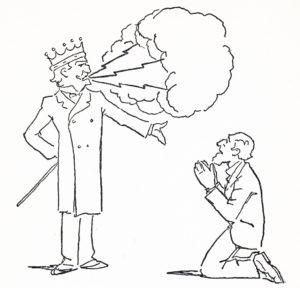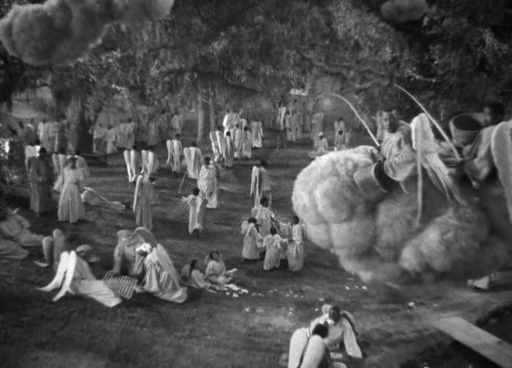Bradford did not see it, but Ol’ Man Adam is imbued with his inherent racism. He means to entertain by portraying rural, uneducated happy-go-lucky African Americans retelling Old Testament stories in a dialect that’s more Bradford’s than theirs. It’s unclear why he chose to do so. Perhaps he thought it was humorous.
Bradford is defended for his sympathy for African Americans, but his vision of African American Heaven is racist. He segregated them in Heaven, where “De Lawd” is a kindly gent who likes “ten-cent seegars” and “b’ild custard.” Heaven is a place where everyone enjoys an eternal fish-fry picnic:
“Well, a long time ago things was diffrunt. Hit wa’ n’t nothin’ on de yearth ’cause hit wa’ n’t no yearth. And hit wa’ n’t nothin’ nowhere and ev’y day was Sunday. Wid de Lawd r’ared back preachin’ all day long ev’y day. ‘Ceptin’ on Saddy, and den ev’ybody was out to de fish fry.
So one day ev’tbody was out to de fish fry, eatin’ fish and b’iled custard and carryin’ on, to all at once de lawd swallowed sdome b’iled custard which didn’t suit his tas’e.
“Dis cusstard,” say de Lawd, “ain’t seasoned right. Hit’s too thick.”
“Hits got a heap of sugar and aigs and milk and things in hit, lawd, say Gabriel.
“I know,” say de Lawd, “but hit tas’es like hit needs jest a little bit more firmament in hit.
The text illustrations undermine the defense for Ol’ Man Adam. It’s hard to believe that what Bradford did not or could not see were illustrations for Ol’ Man Adam in which A.B. Walker portrayed White people and not African Americans. “De Lawd” speaks in a peculiar African American dialect, but Walker’s illustration is of him a Southern plantation patriarch wearing a crown and dressed in a frock coat. Neither Walker nor Bradford or Harper Brothers, the publisher, recognized these blunders. It was not an accident.

A.B. Walker. “Sin.” 1928. Opening sentence of this chapter is “Well, hit wa’nt long after deyearth got peopleto do de people got to gittin’ in devilment.”
See Roark Bradford. Ol’ Man Adam an’ His Chillun, Being the Tales They Tell about Time When the Lord Walked the Earth Like a Natural Man. Illustrated by A.B. Walker. New York: Harper Brothers, 1928; Marc Connelly. The Green Pastures: A Fable Suggested by Roark Bradford’s Southern Sketches “Ol’ Man Adam an’ His Chillun.” New York: Farrar & Rinehart, 1930; Adele Reinhartz. The Bible and Cinema: Fifty Key Films. Abingdon, Oxon: Routledge, 2012; Text of The Green Pastures: A Fable (1929).
Featured Image: Marc Connelly. The Green Pastures (1930)

